December 2 - 8, 2018: Issue 386
Tim Nossiter
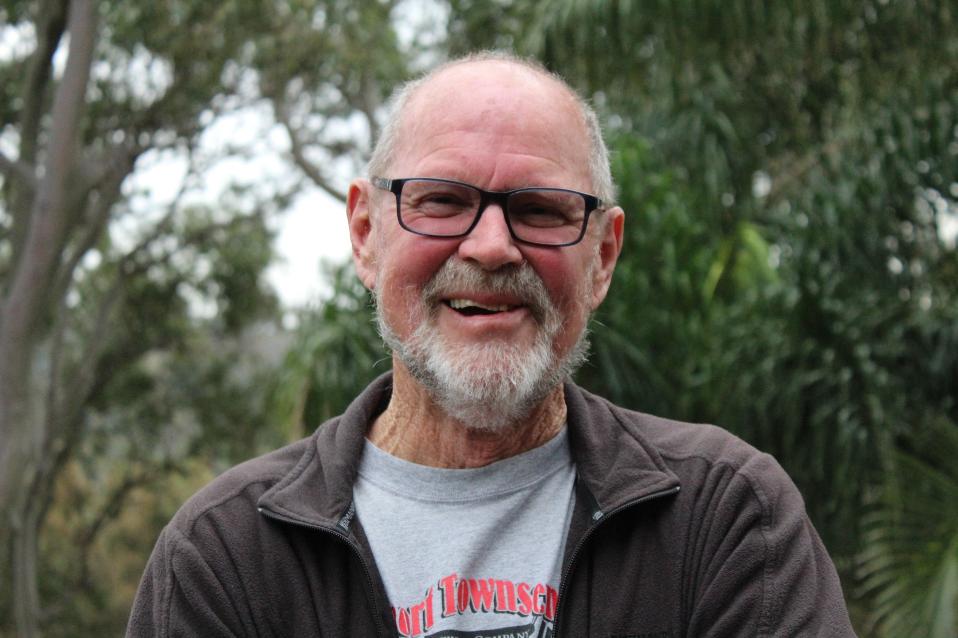
We open with a few insights from Tim Nossiter, youngest son of Richard (Dick) Harwin Nossiter OAM. Richard was the second son of four sons of Harold Nossiter senior, the first Australian to skipper a yacht around the world under an Australian flag from 1935 - 1937 on the schooner Sirius. Mr. Nossiter left Sydney Harbour with the two eldest of his four sons, Harold Junior and Richard (Dick) in July 1935. The Sirius is still sailing, and current owner Simon Morris, is contributing to this Summer of Nossiter Insights project as well.
This is a celebration of sailing - Australian Sailing - brilliant yachts, great people who did much for sailing in Australia and Australia herself, as well as insights that connect to Pittwater from the late 1800's and are still going on in family members who are America's Cup sailors and still competing in International sailing events. There are Royal Prince Alfred Yacht Club associations, Harold Snr. became a member in 1923 but was participating in P.A.Y.C. regattas on the harbour prior to that.
Harold Nossiter and two of his sons Camping at The Basin, circa 1918
For Tim a Life at Sea was and remains an abiding passion - he was bringing a yacht from Tassie to Sydney when we caught up with him earlier this year:
When and where were you born?
At the Mater hospital on September 14th, 1947. I lived at the family home in Northwood. Soon after my grandfather, my father and uncle returned from their round the world sail in the Sirius dad (Rick – Dick – Nossiter OAM) went to war. Dad was on loan to the Royal Navy and did a full six years service during World War II.
He was the Captain of five different vessels during that time, small trawlers to start with, then corvettes. He stayed on for nearly a year after the war, went to Germany and was involved in getting the fishing fleet in Germany back on its feet. The people there didn’t have enough food, they were starving.
He was based in Liverpool for quite a while and met mum there. Mum was born and raised in Liverpool. She was in the Wrens and they met there and married in 1941.
Mum came out as a war bride and dad returned on a naval ship.
When did they first bring you out to Pittwater on a boat?
As a baby. Dad had an 18 footer skiff and converted it. He put a deck on it. He and his brother Harold used to sail it up from Sydney up to Pittwater. We used to come up here for our annual holidays, rent a house at Little Mackeral. I remember dad used to moor it out the front and a southerly came up once and it dragged its anchor and got smashed up on the rocks.
After that he bought a 28 footer called ‘Scotia’ that we all grew up on. We grew up sailing. Dad always had a yacht which we’d spend the bulk of our Summers on.
I grew up in the same house dad grew up in at Northwood, the same place the Sirius left from and returned to. We had the most unbelievable childhood, we really did – just wonderful.
Just incidentally, while I think of it, that house at Northwood sold about six months ago for 9 million dollars. It had had another storey put on top and had been renovated, but an astronomical sum nonetheless.
We spent most of our time on the harbour but would come up here too.
Do you have any fond early memories associated with here?
The earlier ones, when I was only 3, are not too strong. When we got Scotia however; those are still very vivid. I remember rowing aside to the Pittwater side of Palm Beach and going up to the local shop there – I would have been 5 or 6 by then.
I remember going up Refuge and under the waterfall there. We actually caught a water snake there once.
What was Palm Beach like?
Far less houses and those that were here were all weekenders, what we call ‘shacks’ in Tassie.
Where was the shop?
On the corner, where the bottleshop is now, and there was a wharf going out behind it. It was just a simple corner store then. We know Ian Begg, the shipwright, who now runs the slipway further down, he took that over from Peter Kershaw, his uncle. Ian Begg did his apprenticeship with Peter. His father and uncle grew up in Northwood, so more connections there too.
Did you stay on the Scotia when up here?
Yes. I remember once when we were on the harbour we were at Quarantine, or Store Beach as we call it, and Sirius was there. My grandfather had sold it to a car dealer. Dad went over to say hallo and my brother Steven got to spend the night on board.
Later on dad took the three of us sailing up to Broughton Island, another fabulous adventure.
Eventually we all grew up and I recall a family friend had a yacht built called ‘Altruna’ which went in the Sydney to Hobart yacht race with all us aboard, dad and his three sons. I did two Sydney to Hobarts, 1965 and 1966, and Steven just did the one. Dad did more. We also had our cousin Tony on board for one of them, which was great. Tony was a tugboat guy his whole career.
What are some of your sailing adventures after your childhood?
All I ever wanted to do was go cruising.
When I was 24 we had the 1970 bicentenary of Cooks discovery of the east coast of Australia. The celebrations were held in Sydney. That was the first modern gathering of Tall Ships in Sydney Harbour.
I’ll never forget it, there was an unbelievable atmosphere in Sydney. There was one coming out from Norway. The First Mate on board was an English guy who happened to be the son of a lady whom my mother went to school with in the U.K., and they had remained friends since school. She wrote to my mother, ‘Roger is on this boat called the ‘Regina Maris’ and it would lovely if you could meet him when they arrive’.
The Regina Maris was about a 95 foot on the deck three masted barquentine, so about 140 foot overall. On the way out, just after they’d left Madeira, with all the yards braced hard around, they were caught in a storm. I think they may have had too much sail up. The storm hit them and pulled the main mast down, which pulled the other two masts down.
They made it back to Norway, totally re-rigged the ship with an even bigger rig than before and had a mad dash to try and make it in time for the Cook Bicentenary. They didn’t make it in time for the official celebrations but did arrive a few weeks later.
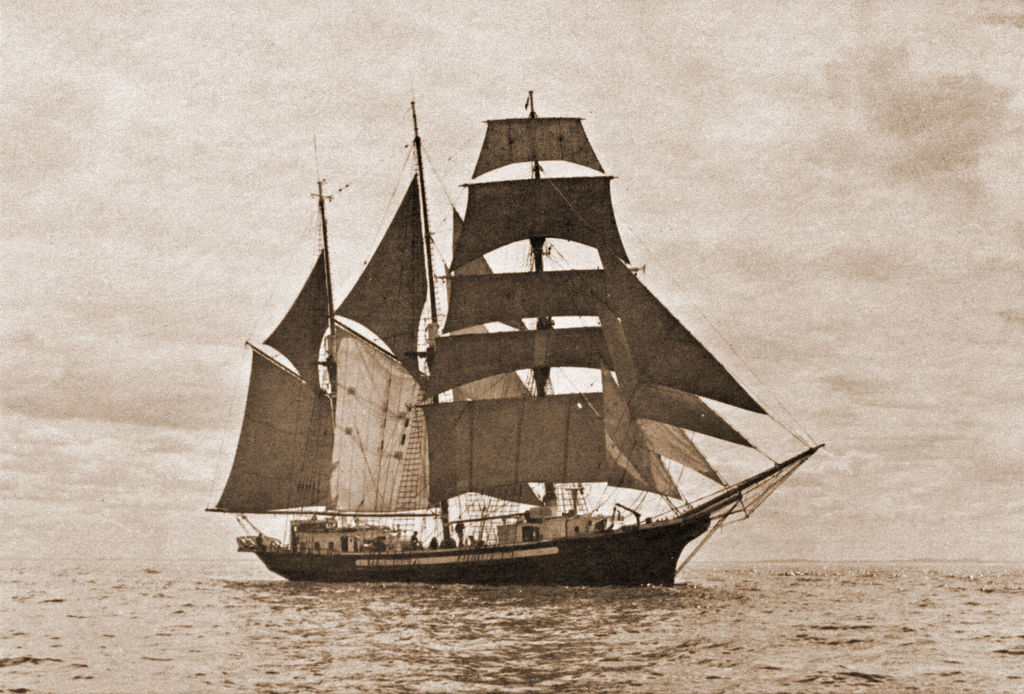
The Regina Maris - historic postcard
Mum and dad knew the gentleman in the RAN who was looking after all the Tall Ships and so managed to get into the dock as soon as she arrived. A mate and I watched her come in through the Heads from the Botanical Gardens but we weren’t allowed in the official area at the dock.
I was watching, thinking ‘those lucky guys.’
After about an hour mum had secured permission for us to go in. as soon as I got there mum said ‘how would you like to go away on her?’
She had already asked Roger and there was a chance I could which materialised.
She was magic. I embarked on this really prolonged voyage back to Norway. They were actually doing a documentary called ‘In the Wake of Captain Cook’. A lot of that had fallen apart due to the dismasting of the ship.
The owner wanted to get the ship back to Norway – she was privately owned, no passengers, just crew, a very young crew.
We went across the Pacific. We had the most beautiful three day sail from Brisbane. After that wonderful three days we motor sailed virtually all the way to Norway; across the tropics, through the pacific. We went to Tahiti from Brisbane, then through the Pitcairn Island, the whole thing was such an incredible adventure – we had a half day shore leave there.
From the Pitcairn’s we were meant to go to Valparaiso in Chile and because it was Winter time we were going to wait for Summer to sail around Cape Horn. He was a Master Mariner and wanted to sail around Cape Horn as he’d sailed around there in this same ship a couple of years beforehand and became what is known as an ‘Albatross of the Cape Horn Club’. He wanted his brother, another Master Mariner who was on board with us, to become the same.
A half hour after we left Pitcairn Island however, there was a notice posted up in the mess saying we were now bound for Monte Verdejo via Cape Horn, so the other side of South America. It was the second worst time of the year to be doing this.
We set off. Half the crew didn’t want to go. There was only one guy among all the crew who would go no matter what. Most thought this was a pretty foolhardy thing for the Captain to do; a leaking ship, timbers not sound, built in 1908 – a Baltic trader originally.
Anyway he said we’d cut up blankets for extra warmth, and wouldn’t sail at night because of icebergs. Either way, half the crew weren’t going to go no matter what, and I was among them but didn’t know where I stood legally as far as a mutiny is concerned, and then we hit a full-on storm. We were still a reasonable way south at that time and were hove-to for three days.
During this time things really blew up on board, one chap in particular becoming quite adamant that he was not going around the Horn. I think the storm made have scared the Captain a bit too and he could see it was just going to be trouble.
As soon as the storm settled he said ‘right, we’re bound for the Panama’. The mutinous crew members were kicked off in the first port of call, which was a little place called Telarah in Peru.
We then went through the Panama and back to Norway. He had had the ship for six years then and sold it to an American car dealer. We stayed on to take her across and she ended up down at the Canary Islands. We left the ship there. He had wanted us to stay on to train people, as there were only a few of us left on board that knew the ship, but I left the ship there.
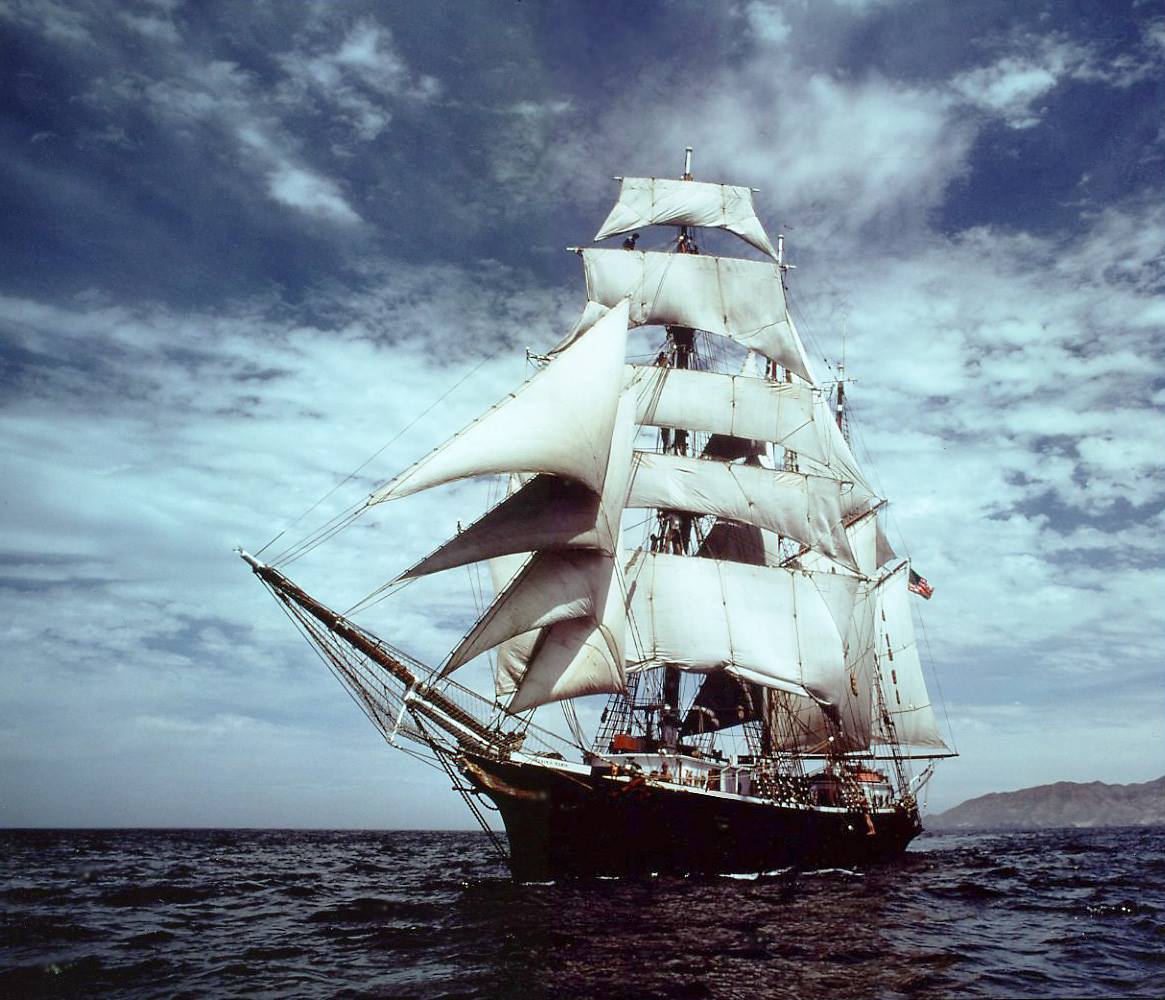
Regina Maris in 1978, Magdelena Bay, Baja California, Credit: Ken Balcomb. Photo courtesy Regina Maris Society
Did you think about your father and your grandfather while you were caught in that storm or while sailing the more pleasant legs?
At times. Their worst storm was off the New South Wales coast though, on their return! They were hove-to for about three days then, on their way home.
What did you do when you came home?
I was only back about a week and I noticed a barquentine down in Neutral Bay. She turned out to be a vessel called the ‘New Endeavour’. She was actually a sister ship to the vessel I’d just been on, the Regina Maris; they had identical hulls, both built by Rig Anderson, both oak.
I called in down there and met a guy called Tiger Timbs (Anthony), who was First Mate, and eventually I managed to get a job on board that ship. This was cruising around Sydney Harbour doing charter work. Fauna Productions, the Skippy people, owned her then and they’d just finished making a series up in the Barrier Reef called 'Barrier Reef'.
This was around November, so there were a lot of Christmas charters and lunch cruises, that sort of thing.
That is where I met my first wife. Eventually we married and I left the ship but had become very good friends with the crew on board. That was very significant for me as Tiger wanted his own ship and had already had planes drawn up by Joe Adams for a small brigantine.
At Newport – yes, we found a Women’s Weekly article on your first marriage during our Nossiter research
Yes, a friend knew someone who worked there and a friend had loaned us a Halverson for our honeymoon. We had the reception at their house, which was on the waterfront at Newport, and then just rowed out to the Halverson and took off to spend our time around here.
Later on we bought our own yacht, the Yanda, a 35 footer. We’d go up to the Whitsundays’ in her, would spend three months up there and then come back. We eventually sold that boat.
We had two daughters, Yanda and Nicole, who now have two children each of their own.
That marriage unfortunately didn’t last.
In the meantime Tiger and his mates had found an old steel hull in Sweden, called ‘Merry’ which they brought across, and which was renamed ‘Eye of the Wind’. There were five in the syndicate, all of whom stemmed out of New Endeavour. They totally rebuilt her over a number of years.
Ten years later they sailed back into Sydney Harbour in this ship and that’s when I caught up with them. They said ‘do you want to come sailing?’, and my marriage had fallen apart, so I jumped on board.
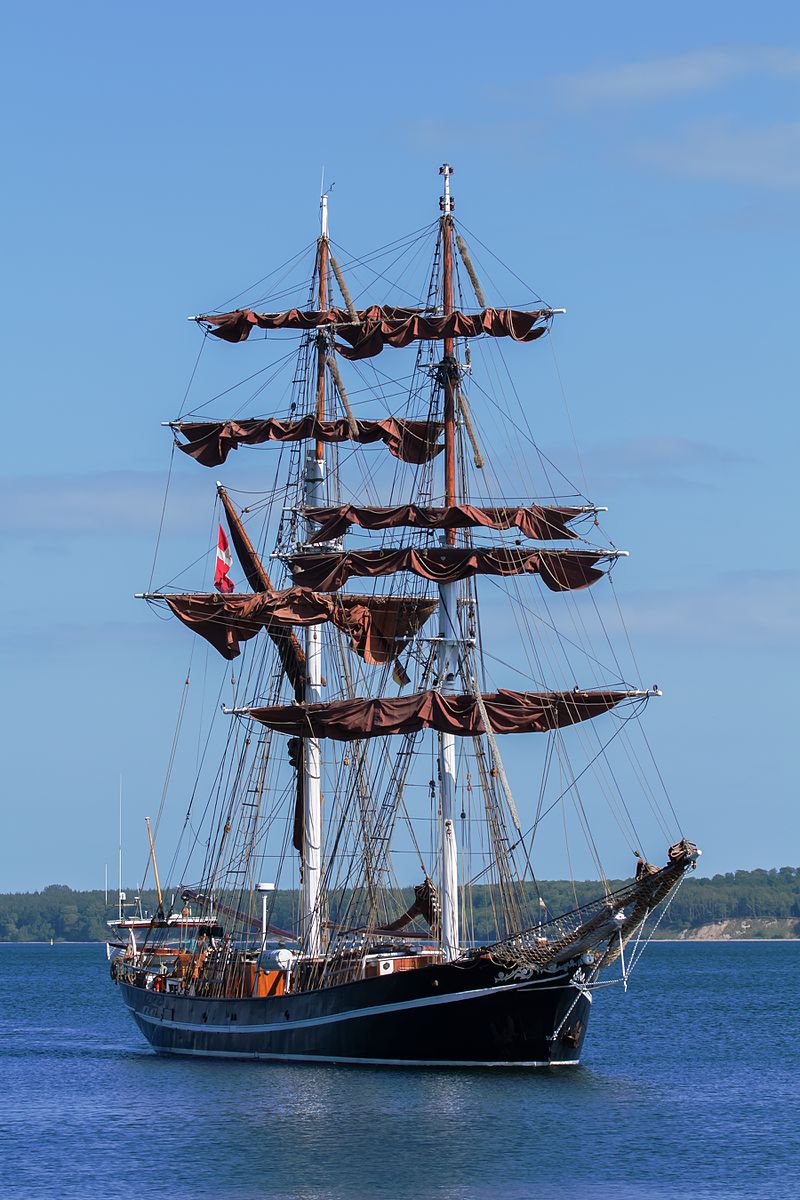
‘Eye of the Wind’ in 2010
Where did you go?
The first trip I did we left Sydney and went out into the Pacific, to Lord Howe, Bay of Islands. It was just unbelievable, the way she was operated, everyone was friends, the passengers who came were all part of the ship and friends. It certainly helped me at that time.
I did two circuits around the Pacific in her. That’s also how I met my second wife, on board her.
So I left; we wanted to start a family, and I moved to Tassie.
The ship, at that stage, had started to do Summers down in Tassie, so we ended up running her shoreside things in Tassie for quite a few years. So they have been lifelong friends.
My second marriage broke down while this was going on.
In the meantime I got a job at the Marine Discovery Centre in Woodbridge in Tasmania and was Skippering their five-foot timber ex-research vessel called RV “Penghana”. I consider myself to be very lucky to have got a job on her – work I did for 25 years. I was the only Skipper in Australia employed by an Education Department then.
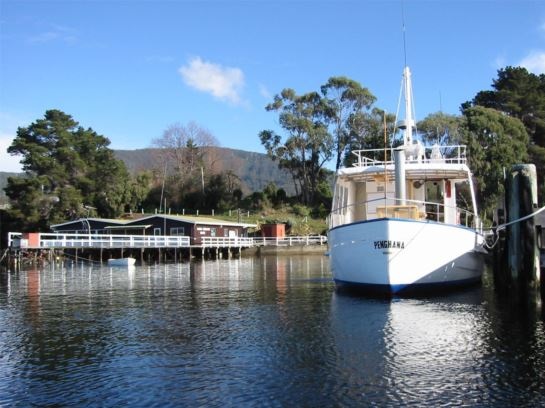
RV “Penghana” and Marine discovery Centre - photo courtesy Woodbridge School and Marine Discovery Centre
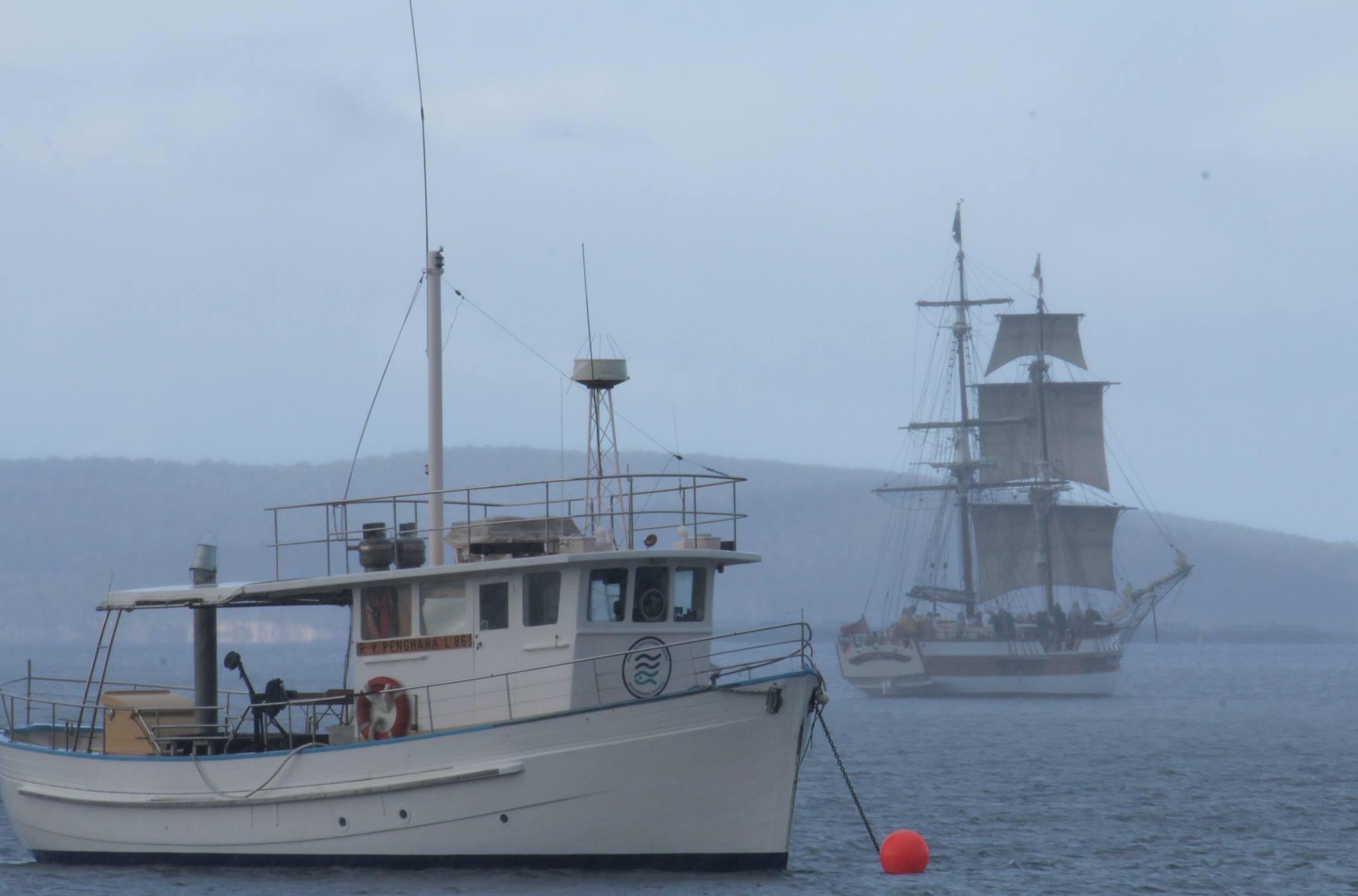
June 7, 2013: Today was a special day for students at Woodbridge School, from prep to grade 10. The Lady Nelson berthed at the Woodbridge Jetty giving students the opportunity to have a close look over her before setting sail around Peppermint Bay with a the older students on board, seen here with their school's Marine Discovery Centre research vessel Penghana in foreground. photo courtesy Woodbridge School and Marine Discovery Centre
In the meantime Eye of the Wind had been doing some circumnavigation work. During my work at Woodbridge I became due for some long service leave. I said ‘Tiger, can I join you?’
I met them in Bali while they were doing their circumnavigation and went across the Indian Ocean with them. We went down to Cape Town – this was a four month trip.
You have actually been all around the world on a boat too then?
All but 15 degrees of longitude.
I met my third wife, Pam, through work – she was my decky (deckhand) aboard the teaching vessel – she taught them and I Skippered the boat. We’ve been together for 20 years now.
When we married we went up and chartered Sirius for two weeks from Simon Morris. Tiger and his wife came with us as weer two other ex-Eye of the Wind people as well as Simon.
What was it like being on the Sirius after all that time?
Well, as you can imagine, stepping on board of her was very very special for me. Straight after we were married I skyped dad from the boat (Sirius); so it was fabulous to share that with him too. He passed away later that year.
Then he was 103 and living by himself at home; he was an amazing man. We were there for his 103rd birthday on the 22nd of June, after we’d been on the Sirius, and had all my grandchildren there as well. Pam and I stayed there that night.
In the morning he came into the kitchen whistling, he always used to get up very early.
I said ‘did you have a good day yesterday dad for your birthday?’
‘I had a wonderful day’ he answered, full of beans.
We left that afternoon, we were flying over to America. That night he had a stumble in the kitchen, a dizzy spell, which was actually a mini-stroke, and twisted his foot. He called my brother Hugh up the next day as he couldn’t walk at that stage. Hugh got him up to the hospital and while they were x-raying his foot he had a full blown stroke and never really recovered from that. He ended up in a nursing home for the last six months and died soon after Christmas that year.
But what a life though – lived looking after himself right up to his 103rd birthday.
What did you train to do on leaving school?
Well I wish I’d trained as Tony did to be a tugboat operator – a varied job and one where you’re on the water all the time. Although I’ve spent most of my time on the water I never pursued this as a career. I was a Rep. originally, as dad had been too. I was doing that when I left to go aboard the Regina Maris.
Have your brothers stayed on the water too?
Yes, they’ve both had a boat of one sort or another most of their lives. Hugh has a yacht that he’s had for around 40 years now.
So you have ended up having a career in work that kept you on a boat anyway though?
Exactly. If I had of known then what I know now I certainly would have pursued that work, even if it was starting off on the ferries on the harbour to get my tickets.
How many children do you have?
Two daughters and two sons who are in Tassie.
Do they like being on the water?
Jack is very keen to do more. Jack did this trip with us sailing the old pearling lugger we brought up from Tasmania. He’s very keen to do a Sydney to Hobart race. Jess, my eldest son, is in advertising so he’s pretty focussed on that.
My daughter Nicole hasn’t been interested in it, but she loves running, did the City to surf again this year.
There is still three generations of Nossiters who love the water though, perhaps a fourth generation soon – where do you think it comes from?
Well my grandfather started it.
Did his father sail too?
Not that I know of. Harold Senior was born in Hunters Hill on the 12th of July 1875 and he died on the 12th of July 1956.
He was the Wine and Spirits manager at Dalgety’s as well as the vice-president of the Wine and Spirits association. He introduced White Horse scotch into Australia as the scotch Dalgety’s had at the time went broke in Scotland. He got the agency for White Horse, which you rarely see these days.
When dad was born they were living at Tennyson, which is just near Putney, in a beautiful house which is virtually identical to this day; slate roof still intact, still called ‘Harwin’. My grandfather’s wifes’ named was Winifred Harwin, dad’s middle name was Harwin, and I think his brother John had Harwin as his middle name too. My son Jack had a son who was born not long after dad’s funeral he is named Eli Harwin.
My grandfather then bought a block in Northwood and had the house built. While that was being built they lived down near the bay, pretty much in a shack with a tent lean-to off it apparently; which the kids loved and my grandmother hated.
So we lived on the water too and had pretty much the same childhood dad had – idyllic.
Do you know what your great-grandfather did?
No. He, Thomas Simister, and one of his brothers migrated out from the U.K. together. I think one of them went to New Zealand and stayed there. So there are Nossiters there as well.
I don’t think they did much as their father was very wealthy. We did have a copy of his original Will, all beautifully handwritten, in which he left all his property etc. to such and such and Thomas and his brother were to receive two pounds each, and said ‘for all the advances that you have already had’. So he was obviously living in Hunters Hill when my grandfather was born.
Do you have any memories of your grandfather?
Oh yes. He was very Victorian I’d say. He was always dressed in a suit. I remember more about my grandmother as she lived a lot longer than him.
I remember that the boat he owned before he got married was called ‘Arrow’. He used to sail up to Pittwater on her.
On my honeymoon with Julia on the Halverson, we went looking for an old family anecdote. He had carved the name of that boat and his initials in a tree up from The Basin.
When you across the inlet there’s a little creek running down there and it was up there. We went in search of this during our honeymoon and I found it; it was opposite the big rocks where the water comes down. It had ‘Arrow’, H.N. and 18??’.
So he had been coming here for a while too. We found this in 1972. Amazing. It has gone now though.
When you see my grandfather in early sailing photos aboard Arrow you see he had an all female crew, he loved women, as did my father during some of his amateur race sailing days – which was quite unusual in those days in my grandfather’s case, and even my father’s.
But he is always dressed up; a tie, a hat.
What were your favourite places to go to on the harbour?
Our main beach was always Quarantine. We went to Castle Rock quite a few times, and Taylor Bay. Mum and dad would always invite friends along, and we’d have mates aboard too.
We’d take off early in the morning, we had this dog ‘Chippy’ that we had to find and lock in the veranda and ask a neighbour to let him out after we’d gone. If we couldn’t find him we’d take off, turn around, and there’s Chippy in the water.
He used to drive dad mad. He’d say ‘ go and get him in the dinghy’.
There was one classic I recall. We’d taken off, turned around, there was Chippy. Dad said ‘I’m not going to get him this time, he can fend for himself’. Us boys were ‘dad, dad – he’ll drown – a shark will get him!’ – he’d already swum a long way.
So dad ended up picking him up and putting him aboard, which he hated doing. We went to Quarantine, where the dog got lost – I found him again. So we were sailing back home in the afternoon; a typical day for us – head up there in the morning and sail with the sea breeze back in the afternoon. We were off Bradleys’ and an 18footer race was on, we were right in the middle of it, and the dog fell overboard.
We weren’t far off Bradleys’ so the dog swam ashore. Now, this dog would bite strangers occasionally, so we knew we had to get him. So good old mum got in the dinghy and she’s moving through these 18footers – we’re all yelling out ‘good on you mum!’
She rowed ashore, got Chippy, and rowed back out to us. It was very funny for us. He was a real character that dog.
Did your dad tell you much about his Service during WWII?
Some, he did an immense amount for others. I recall one trip up into the Arctic circle he spoke of, which was when he got his DSC. They were basically suicide missions those trips. Luckily he survived and only did the one trip there and back. Those were horrific missions, absolutely horrific.
Did he come out scarred do you think?
Not at all. He enjoyed his time in the Navy. His fellow officers became lifelong friends of his.
He said he was pretty frightened in the beginning, especially when he was going to do this Murmansk run. My mum miscarried because she was so nervous about it, that’s what she put it down to. He said he suddenly thought ‘I’m going to die’ and then, as he said, ‘just as suddenly all my fear left me’.
He was the most beautiful man, just lovely – everyone adored him. He was humble, always ready to have a laugh, a wonderful guy.
How long did he sail for?
They sold Scotia eventually as we’d all left home and weren’t sailing with him anymore. He then sailed with a childhood mate of his, Jim Griffin. He did a couple of Hobart’s with Jim and would have been in his early 60s by then.
He sailed with me on the Yanda, joined me in Mooloolaba and sailed with us at to Mackay, was with us for two weeks. He would have been about 68 then. But then, I’ve just done this trip up from Tasmania and I’ll be 71 this year.
Dad was always quite fit though. Apart from sailing with my brothers up in Lake Macquarie, as they are both living in Newcastle now, and that’s where mum and dad ended up living too, the sail he did with me on the Yanda would have been the last longer at sea sail.
He also did one trip on Eye of the Wind back to Sydney with us from Hobart one year too – that was in 1984, so dad would have been 73 then. That would have been the last long one he did – and a wonderful experience for me.
When we spoke a few weeks back you mentioned wanting to place these materials where the Australian public may have access to them. What form is that taking?
So I’m donating all these materials to the Australian National Maritime Museum. These are dad’s diaries – there are five altogether. Sometimes he kept pretty good ones, at other times he must have met a girl somewhere or something. My grandfather also asked him to learn Navigation so he got a Yacht Masters Certificate – which is Number 2 in Australia – so that will go to the ANMM too. I have his passport from the voyage, which has very few stamps in it as they were mostly at sea. I also have the Charts from the voyage, so we want to give them those as well.
They already have the photo collection so hopefully with this extra material they will be able to have a definitive record they can share.
With those, and the series of pages Pittwater Online News is putting together with these records, photos and Simon's help on the Sirius, a record will be available for all who are interested.
Richard Nossiter's Yachtmaster Certificate front
Richard Nossiter's Yachtmaster Certificate back
What are your favourite places in Pittwater and why?
Well, Little Mackerel Beach of course – so many memories there. The Basin – another family place for us. And Palm Beach of course – just fabulous times just rowing ashore and so lovely and hardly anyone else here – although that was in the early 1950’s. Refuge of course, a beautiful place we’d go to whenever we were up here.
What is your ‘motto for life’ or a favourite phrase you try to live by?
Do as much sailing as you possibly can.
I’m also getting very much into my grandchildren now of course – they’re all so different, it surprises me how different each is – so enjoy your blessings in that case, and so often that is who we have in our lives – our partners, our children, our grandchildren.
A Few Extras:
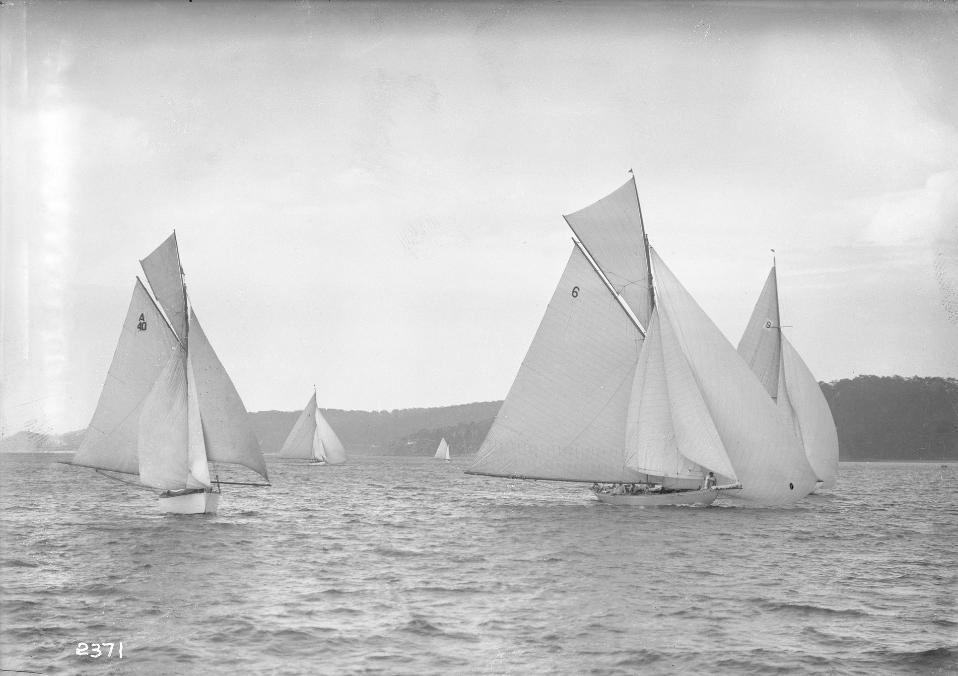
Sloops racing, probably at the Pittwater Regatta
The vessel RAWHITI appears at the centre of this image with the number '6' on the mainsail. To the left is CUTTY SARK, displaying the text 'A 40' and the vessel to the far right with the number '19' on the mainsail is probably BONA. Photo courtesy Australian National Maritime Museum. Image No. Object number 00011538
This photo is part of the Australian National Maritime Museum’s William Hall collection. The Hall collection combines photographs from both William J Hall and his father William Frederick Hall.
THE R.P.A.Y.C.'s race for the Nossiter Cup over the Manly course on Sydney Harbour on Saturday brought out a fair fleet, but the wind was light and unsatisfactory. Mr. Palmer's Brand V., which lost her mast in the Basin Cup, reappeared, and, suited by the light wind, scored a win.
The staysail-rigged schooner Windward came second, Mr. Frank Albert's Rawhiti third. With Rawhiti on scratch, Brand was allowed 13 minutes, Windward 26 minutes. Others in the race were Bona, Utiekah II., and Morna.
The restricted class was won by N.S.W. III., which sailed under the Bermuda rig, Mr. J. L. Milson at the helm. She defeated Wattle by 1 minute 44 seconds. The World of Sport (1931, February 11). Sydney Mail (NSW : 1912 - 1938), p. 31. Retrieved from http://nla.gov.au/nla.news-article15979160
A POEM OF BILLOWING CANVAS
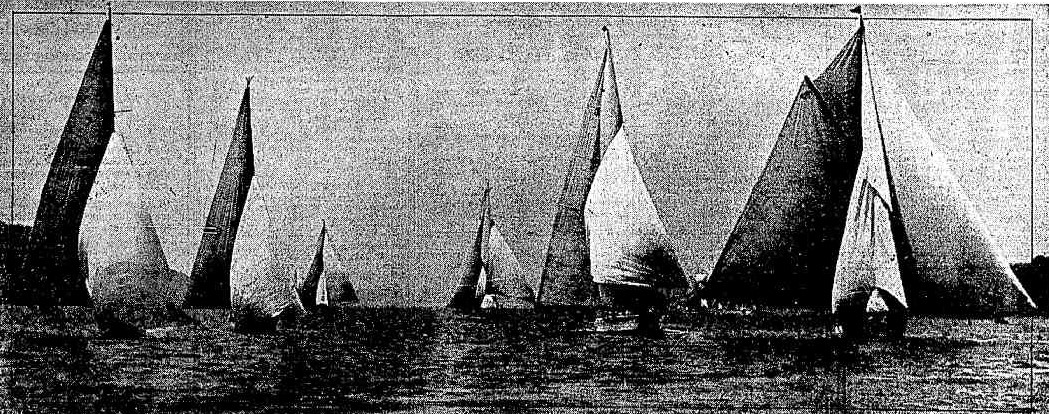
Yachts sweeping up to the finishing line in one of the races at the Pittwater (N.S.W.) Jubilee Regatta on Saturday. Shown in the photograph are Norn (No. 7), Bona, Utiekah II, second from right, and Morna (No. 4). A POEM OF BILLOWING CANVAS (1931, December 30). Referee (Sydney, NSW : 1886 - 1939), p. 22. Retrieved from http://nla.gov.au/nla.news-article136750488
NEARING THE FINISHING LINE IN THE JOHN ROCHE HANDICAP FOR ALL YACHTS ON SATURDAY AT THE PITTWATER REGATTA.
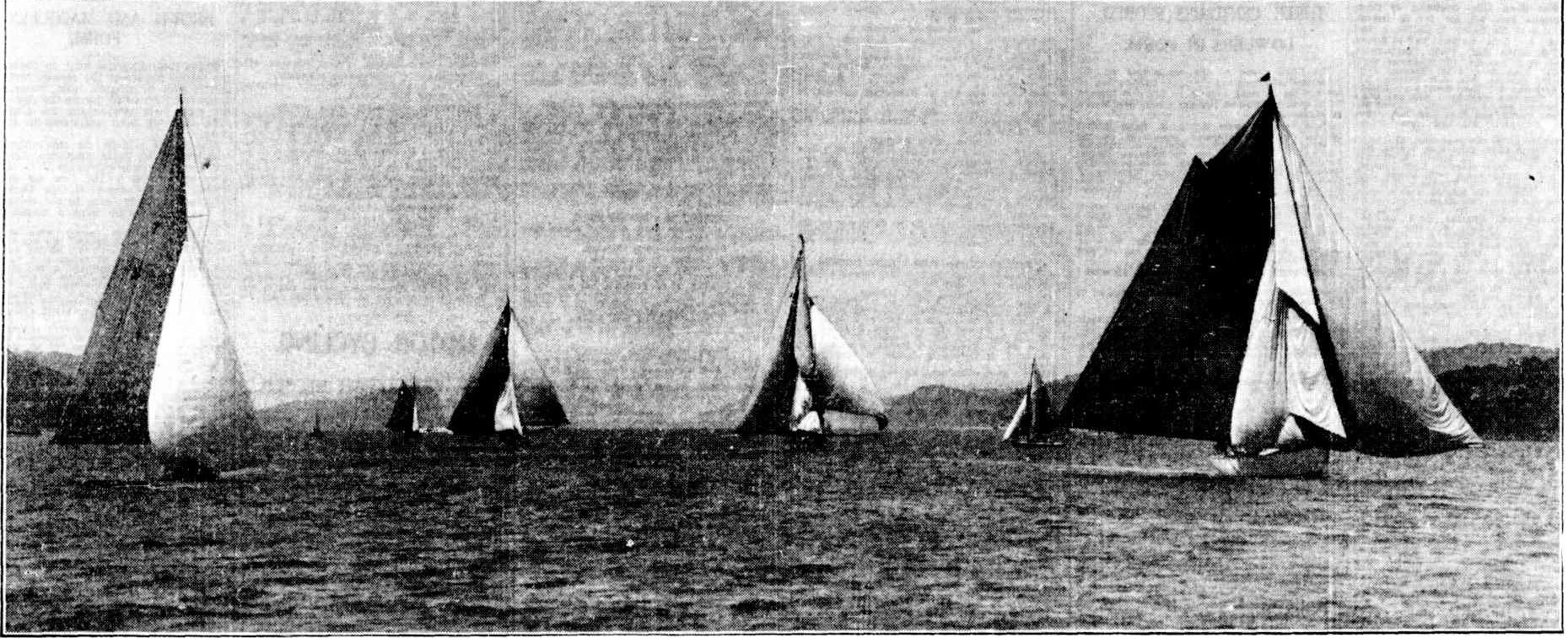
The yachts are, from left to right: Norn (A. Stevens), Bona (A. J. Wilson), the winner Utiekah II. (H. G. Nossiter), and Morna (W. Henderson ), third. The yachts were sailed by members of the crews other than the regular skippers. NEARING THE FINISHING LINE IN THE JOHN ROCHE HANDICAP FOR ALL YACHTS ON SATURDAY AT THE PITTWATER REGATTA. (1931, December 28). The Sydney Morning Herald (NSW : 1842 - 1954), p. 4. Retrieved from http://nla.gov.au/nla.news-article16819029
Mariners All
There is great joy, consistent with respectability and modesty, in the home circle of Mr. H. Nossiter, at Northwood, on the Lane Cove River. It all arose over the possession of a cup of ancient origin. When Mr. Nossiter and his four mariner sons are not at home at Northwood they are at home in yachts on the Harbour. Last Saturday, Mr. Nossiter, senior, sailed his Utiekah II, a winning race for the possession of the F. J. Jackson Cup. That a cup should have survived for 58 years the rust and moths that corrupt, and the thieves that break through and steal, is wonderful, but apparently it has, and the veteran yachtsman has possession of it. Always a sea lover, Mr. Nossiter has no time for anything else but the proper conduct of an Important department at Dalgety's and yachting. He probably could have been an International League Rugby player or a rider of buckjumpers in a rodeo show, but he started sailing in his Infancy, and has remained a sailor ever since. In his younger days he owned the 20-footer Ladas, the Viking, the Arrow, and the Zenita in turn. Now he has two Utiekahs, one the yacht which he sails with his two older sons, and the other a dinghy sailed by the younger boys. When the racing season is over he and the boys go cruising up and down the coast, and they spend every week-end on the yacht in one of the bays of the Harbor. Mariners All (1932, November 23). Referee (Sydney, NSW : 1886 - 1939), p. 12. Retrieved from http://nla.gov.au/nla.news-article135334787
CRUISING AT BROKEN BAY
From all the various amusements excursions heralded by more or less enticing announcements we may perhaps turn aside and give a short record of our yachtsmen and boat sailors who, whenever three or four days can be gained, invariably steal away along some 17 miles of open sea, and make Broken Bay a second Port Jackson. Tuesday morning the first of a fleet of 25 boats, or 20 excluding yachts, started with a fresh south-west wind, and arrived at midday under Barrenjoey, where boats generally send a wire back to Sydney announcing a late arrival. This was the Wanganella. On Wednesday evening she was joined by the Muriel, Pleiades, Iris, and Corinne. The Waitango arrived at midnight Wednesday, and before noon on Thursday the Maritana, Dreamland, Lottie, Snowdrop, Weringa (Mr. Charlton), Viking, Curlew, Cutty Sark, Asteroid, Pearl, Sibyl, Agnes, Zuluiku, Psyche, Colleen Bawn, had sailed round; while on Friday the Violet, Mistral, and Sao arrived. Besides these, which sailed round, many brought skiffs on steamers, which ensures a camp, if winds are not suitable for sailing round. However, fortunately, the wind was fair both ways, and the sea for the most part smooth, with a fair swell.
If any boats have been omitted from this list it is because they were not seen among the more popular haunts; but as it is, it may be taken as showing; that our Sydney amateurs have learnt something practical as well as racing in smooth water, as the fastest boats we have of all the lengths 20 feet and over prove themselves quite safe outside with pleasure sails.
Crews of two up to six or seven seemed to be the usual party, while the smallest boats were the Iris, 10 feet, and Cutty Sark 20, Corinne 21 feet, and others, as will be seen from the list. From Beroura Creek, some 20 miles or more up, down to Pittwater, and between those places, Cowan Creek, Wagonga Creek, and the now-famous rendezvous, the Basin, boats covered in could be seen.
The weather was very cool, but the wind very unsteady and shifting. Fish did not seem very plentiful. On Saturday evening most of the boats came down the river to the Basin, where there were 12 boats and three yachts at anchor; in fact, nowhere in Sydney harbour was there ever such a fleet of boats and boating men as occupied the bay that evening.
On Sunday morning, from daylight until noon, the boots began to drop down to the Heads, the Cutty Sark getting away at 6 a.m., and must have been one of the first back. About noon, when the sea breeze was well set, there wore 11 boats, not counting yachts, between North Head and Broken Bay-a long line right up the coast. The Dreamland and Wanganella happened to jibe round Barranjoey together, and were about 12 minutes apart at North Head and there must have been other pairs of boats on the way down pretty well matched. By 2 in the afternoon all except one or two were back, some going to Manly to dine, and others coming straight down to their moorings. CRUISING AT BROKEN BAY. (1884, December 30). The Sydney Morning Herald (NSW : 1842 - 1954), p. 8. Retrieved from http://nla.gov.au/nla.news-article28365019
NEWPORT ROCK BATHS.
The new rock baths at Newport were opened on Saturday afternoon by the Chief Secretary (Mr. Lazzarini). To mark the completion of the baths the Newport Progress Association, in conjunction with the Newport Amateur Swimming Club, held a carnival for the purpose of raising funds to complete the payment for the construction of the pool.
Mr. T. B. Nossiter (president of the Progress Association) presided. He stated that the cost of the pool, which was 37 feet in length, was £560, of which amount the Warringah Shire Council had contributed £310. The balance of £250 was being found by the association, which already had in hand £175.
Councillor McKillop (president of Warringah Shire Council) paid a tribute to the civic spirit of the members of the progress association. The Newport rock baths were the seventh constructed in the shire, the others being at Harbord, Deewhy, Collaroy, Mona Vale, Avalon, and Palm Beach.
The principal events resulted:-
Boys' handicap, 37yds: E. Hope, 22s, 1; J. Thomson, 16s, 2. 75yds handicap: First heat: Colin Robertson (New-port), 11s, 1; F. Dyer (Newport), 23s, 2. Second heat: Gordon Robertson (Newport), 12s, 1; C. Clarke (Mosman), 9s, 2. Third heat: L. Mulhall (New-port),. 9s, 1; J. G. Blackwood (Mona .Vale), 7s, 2. Final: Colin Robertson, 1; F. Dyer, 2; J. E. Blackwood, 3.
Girls' handicap, 37yds: Miss B. Bolton, 49s, 1; Miss S. Hope, 33s, 2; Miss J. Booth, 11s, 3. 75yds brace relay race-First heat: J. G. Blackwood and, L. W. Hill (Mona Vale), 10s, 1; A. Carnemolla and D. Laidlow (Drummoyne), 4s, 2. Second heat: G. Crockett snd C. Clarke (Mosman), 4s, 1; J. Walker-Smith and T. G. Arndell (Mosman), scr., 2.. Final: Blackwood and Hill, 1; Carnemolla and Laid-low, 2; Crockett and Clarke, 3.
During the afternoon Miss E. Mealing (50yds State champion) and Miss M. Mealing (back-stroke champion), gave exhibition swims. NEWPORT ROCK BATHS. (1926, February 1). The Sydney Morning Herald (NSW : 1842 - 1954), p. 13. Retrieved from http://nla.gov.au/nla.news-article16261163
The sailing ship Regina Maris was originally built as the three-masted topsail schooner Regina in 1908. She was a 144-foot (43.9-meter), wooden, completely fore-and-aft–rigged sailing ship with three masts. She was re-rigged in 1963 as a 148-foot (45.1-meter) barquentine. Regina Maris can reach a speed of up to 12 knots, especially on a half-wind course or with a fresh back-stay breeze.
Her original home port was Amsterdam. Her classification was SI Z1234+, EU 98/18. Her length overall was 48 meters (157 feet). Her beam was 6.90 meters (22.6 feet), with a draught of 2.80 meters (9.2 feet). Her masthead height was 29.00 meters (95 feet). Her displacement was 280 tons with a gross tonnage of 153 tons. She was rigged as a three-masted topsail schooner with a sail area of 720 m² (7,750 square feet) across 11 sails.
Regina was built to ply the Iceland-to-Baltic Sea codfish trade. The original wooden hull was completed in 1908, the 100th hull produced by the shipyard of J. Ring Anderson in Svendborg, Denmark.
On 15 February 1920, Regina was discovered abandoned in the North Sea. Her crew was rescued by the Swedish steamer Fritiof. Regina was towed into IJmuiden, North Holland, Netherland by the Dutch fishing trawler Eendracht II.
Regina at one time was believed to have been involved in the rescue of Danish Jews during World War II, but this was later disproved.
Until 1963, the ship sailed under Norwegian colours and was called Regina, rigged as a three-masted topsail schooner. Following a severe fire in 1963, she was purchased by the Norwegian shipping magnates Siegfried and John Aage Wilson and converted to serve as the latter's private yacht. Rebuilt with a very tall three-masted barquentine rig for this purpose, the ship was renamed Regina Maris ("Queen of the Sea"). Between 1963 and 1984, she was used in many television and movie productions, conducted two global circuits, and underwent stints as a cruise ship, sail training facility, and marine mammal research vessel.
For a number of years Regina Maris was docked in Gloucester, Massachusetts and was in the possession of the Ocean Research and Education Society (ORES)a local non-profit organisation. She was used for day sails and short voyages as scientists and students sampled copepods in the Gulf of Maine, observed whales and other marine mammals but mostly for the pleasure of the Captain....... Volunteers could pay for acting as crew on short voyages and sampled life aboard an old wooden sailing vessel, including standing watch, sleeping in narrow bunks and climbing ratlines, the latter optional. When the organization ran out of money trying to keep Regina seaworthy it is believed that she was sold to Anthony Athanas of Boston's Pier Four restaurant for use as a stationary party ship. One severely cold night with a loud crack she sank. Soon after she was purchased and raised by a group from Long Island that hoped to return her to seaworthy condition.
The vessel was saved from being scuttled by Captain Robert Val Rosenbaum and moved from Boston. Massachusetts, to Greenport, New York, where Rosenbaum founded the Regina Maris Foundation and began a restoration process with 70 local volunteers in 1991. Hurricane Bob hit the east end of Long Island in August 1991, and Captain Rosenbaum scuttled the vessel at her berth to save her from being destroyed by the storm and to prevent the destruction of the nearby historic waterfront buildings. After the storm, the vessel was raised by Captain Rosenbaum and sold for one dollar to facilitate the restoration effort by a newly formed nonprofit organisation. During the next eight years the corporation raised money through donations in Greenport to restore the vessel, but the funds were misappropriated and never found their way into the ship.
The vessel was towed to Glen Cove, New York, in 1998 as part of a plan to revitalise the city′s waterfront. Plans to restore the ship were hampered by the discovery that she was not involved in rescuing Jewish refugees in World War II, as well as the economic impact of the September 11 attacks in 2001. The ship was chronically leaky and sank at the dock in 2002. Efforts to raise her in 2003 damaged her beyond repair. The deck, gunnels, deckhouse, bowsprit, masts, and rigging were preserved and set in concrete on the nearby esplanade. From Wikipedia.
Barquentine "New Endeavour"
Launched 1919 in Svendborg, Denmark, as the three masted schooner "Dana". In 1965 she was purchased by an Australian syndicate (Adventure under Sail), refurbished, refitted as a passenger carrying topsail schooner (all cargo spaces converted to accommodation), and sailed to Sydney arriving 15th March 1966. For the next few years she undertook tourist cruises in the Great Barrier Reef.
In 1968 the rig was altered to barquentine and in December that year she was laid up in Brisbane due to lack of funds. In September 1969 she gained a new lease of life as a film star in the Australian TV series "Barrier Reef". This lasted for a year. After that she gained other employment but she was again laid up in Sydney in 1972, neglected, unmaintained and heavily mortgaged.
In 1977 she was purchased by 9 Sydney ship lovers who formed the Australian Sail Training Association and commenced restoration work.
In 1979 work on restoration was sufficiently progressed to allow the commencement of day sails on Sydney Harbour for various charities associated with youth and also paying passengers.
She eventually was able to undertake short coastal voyages with young trainees but in 1985, during the period that I was Commodore of the association, we had to destroy her by fire in the dry dock in Ballina, NSW, due to the inability to raise the required money (about $300,000) to make her seaworthy. John Briggs - Merchant Navy
Barrier Reef was an Australian television series that was first screened in 1971. Barrier Reef was about a group of marine biologists on board a sailing ship called the New Endeavour, researching around the Great Barrier Reef, off Queensland, Australia. "It was the first series in the world to feature extensive colour underwater filming on location". It was also a unique location for a TV show.
In contrast to TV shows like Riptide or The Outsiders this series was made in Australia, using Australian scripts, featuring Australian leading actors, and covering scientific topics that were uncommon on TV. It was broadcast by BBC, in the USA by NBC, and also by TV stations in Canada, Japan, South America, South Africa and numerous European countries. The series had 39 episodes and was re-run in various markets for many years.
"Barrier Reef". Classic Australian Television. Archived from the original on 22 April 2011. - 'Barrier Reef was sold to over fifty countries, including Britain where it was screened by the BBC. In the U.S. it was picked up by NBC, who were impressed by the underwater scenes, which they called ‘glug glug’. Other countries that bought the series included Canada, Japan, South America, South Africa and most of Europe.'
The Eye of the Wind is a brigantine rigged sailing ship built in 1911 at the C. H. Lühring shipyard in Brake, Germany, originally as a topsail schooner named Friedrich. The Friedrich was initially used as a schooner for the South American hide trade. In 1923 she was registered in Sweden and under the name Merry, and was used for transport in the Baltic and North seas, and for fishing herring off the coast of Iceland during summer. In 1969, then stripped of her masts and sailing as a motor vessel, she was severely damaged in a fire that all but ended her days on the sea.
In 1973 a group of sailing enthusiasts, including Anthony "Tiger" Timbs, who later became her Master, began rebuilding her at Faversham, England. In this restoration she was re-rigged as a brigantine by Master Rigger Wally Buchanan. After the restoration was completed she was given the name Eye of the Wind, inspired by Sir Peter Scott's book published in 1961. In October 1976 she set sail for Australia, the first time since the restoration, three years and eight months after her purchase by the new owners.
In 1978, she set sail from Plymouth as the flagship of Operation Drake, a 2-year sailing expedition, which brought her back to London in December 1980. While under the care of Tiger Timbs the ship was commissioned for several film roles. During the filming of Tai-Pan, the film producers fitted her with a set of tan sails in order to be able to play two different ships. The tan sails were retained after filming.
In 2001, she was taken over by a new owner and registered in Gilleleje, Denmark. Her interior underwent substantial renovations. Also, the new owners decided to call her rig a brig. This was only a change of naming, the rig remained the same since the filming of Tai Pan. Again in 2009 she found a new owner with the Forum Media Group, Germany. From Wikipedia.
The UTIEKAH II - Still On Pittwater - Still Sailing!
UTIEKAH II from Elevate_Visual on Vimeo.